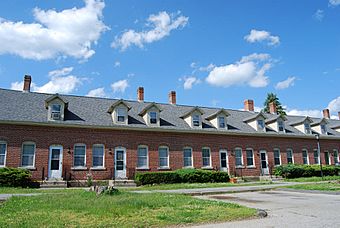Quinebaug Mill–Quebec Square Historic District facts for kids
Quick facts for kids |
|
|
Quinebaug Mill–Quebec Square Historic District
|
|

Row houses in Quebec Square
|
|
| Location | Brooklyn, Connecticut |
|---|---|
| Area | 40 acres (16 ha) |
| Architect | Amos D. Lockwood |
| Architectural style | Greek Revival, Italianate, Queen Anne |
| NRHP reference No. | 85001921 |
| Added to NRHP | August 29, 1985 |
The Quinebaug Mill–Quebec Square Historic District is a special area in Brooklyn, Connecticut. It also reaches a little into Killingly, Connecticut. This district is like a time capsule, showing what a mill village looked like in the 1800s. It's located near the Quinebaug River, Quebec Square, and Elm and S. Main Streets. In 1985, this important place was added to the National Register of Historic Places.
Contents
What is the Quinebaug Mill Historic District?
This historic district is mostly found in a village called Quebec, which is part of East Brooklyn, Connecticut. It includes the old Quinebaug Mill building and the homes where the mill workers lived. These homes are mostly brick row houses. They are built in long rows, or sometimes in smaller groups of two to four homes. The buildings show different styles, like Greek Revival and Queen Anne.
How did the Quinebaug Mill Village begin?
The Quinebaug Mill was started in 1851 by a person named Amos D. Lockwood. It was built right next to the Quinebaug River. By the late 1800s, this mill became one of the biggest and most complete cotton mills in all of Connecticut.
Most of the mill buildings were later destroyed by a fire. However, the part of the mill where weaving happened, called the weave shed, survived. Also, the homes built for the workers were saved. These homes, which date back to 1881, were fixed up in 1984. They now include six brick row houses, each with eight apartments, surrounding a nice green area.
Why is this historic district important?
The Quinebaug Mill–Quebec Square Historic District is a great example of a textile mill village. These villages were a type of company town that was very common in eastern Connecticut during the 1800s. They show how people lived and worked when factories were a big part of life.
Images for kids




